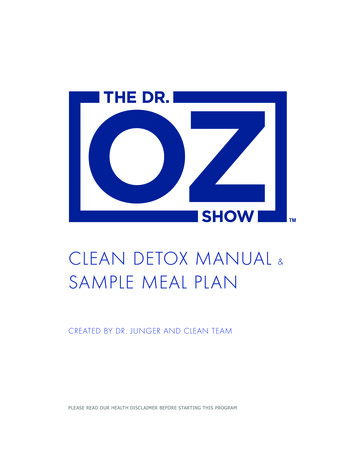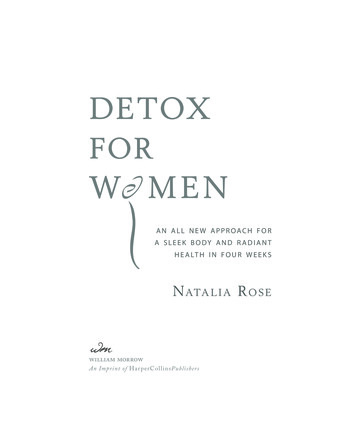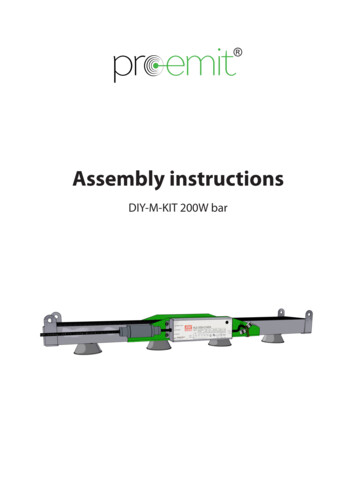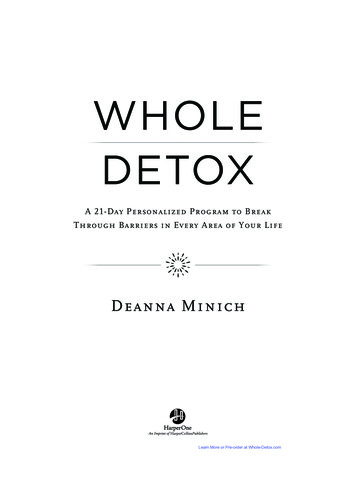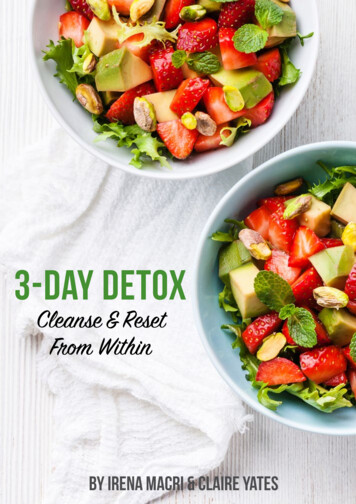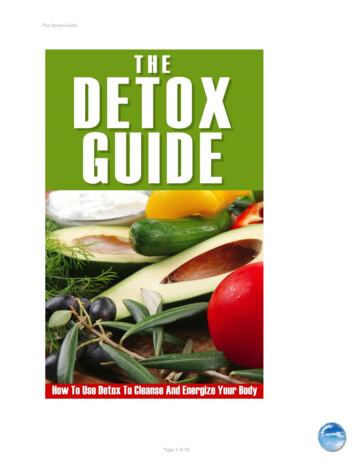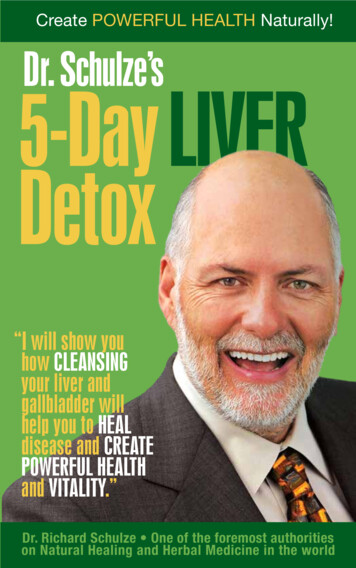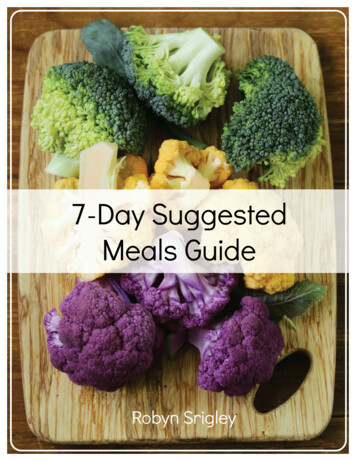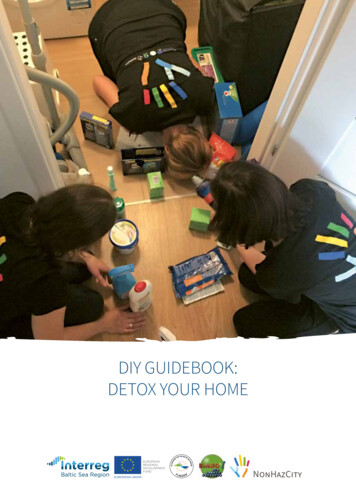
Transcription
DIY GUIDEBOOK:DETOX YOUR HOMENONHAZCITY
CONTENTChapter 1:1.11.21.3Introduction About this guidebook About NonHazCity How to use this guidebook Chapter 2:2.12.22.32.42.52.6Checking your house room-by-room Wardrobe Living room Kitchen Bathroom Children‘s room Storage room and cleaning 4467881012161820Chapter 3: Hazardous substances and health risks 23Chapter 4: Information about pictograms, eco-labels and codes 4.1 Pictograms for classification of hazardous substances 4.2 Recycling codes 4.3 Pictograms for proper handling of cookware and kitchen utensils 4.4 Eco-labels 2626262830Chapter 5: Recipes for cleaning agents 32Chapter 6: Key recommendations & short checklists 6.1 Key recommendations 6.2 Short checklist 343436
Chapter 1: Introduction1.1 About this guidebook4Hazardous substances are ubiquitous in our homes:Most articles, and products we use in our householdsevery day are composed of synthetic substances. Thesesubstances give the products their special characteristics: Cosmetics last longer due to preservatives, foodplastic packaging is soft and smooth due to softenersand the curtains in the living room do not catch fire dueto flame retardants. Unfortunately, some of thesesubstances are hazardous and harmful to our health andthe environment.We come into contact with these substances every day.We eat them when we consume food wrapped in plastic.We drink them when we drink water from a plastic waterbottle. We even breathe them in when we are exposed toPVC flooring and absorb them through our skin when wetouch certain textiles and yoga mats. These are only afew examples that make up the sum of all contact wehave with hazardous substances on an average day.Consider that this exposure continues every day, everyweek, every month - year after year. All of this adds up toa remarkable amount of exposure time. This does notmean that we all are becoming sick. But some of us do!In fact, as the methodology to study these topics and theproblems arising are relatively new the consequences ofthis long-term exposure and the complex compositionand mixture of many different chemicals found in ahousehold is not a very well researched field. Relevantstudies must take place over several decades and theygenerally have to contend with a big problem: Demonstrating a link between cause and effect can be verydifficult.That being said, many of the substances are suspected tobe extremely harmful. They are said to cause cancer,allergies, reproductive issues, and developmentaldisorders in babies and children. In their molecularstructure some substances (so-called endocrine disrupters) are so similar to hormones that they may bemisinterpreted by the body and disbalance our hormonesystems even when in very low concentrations.New chemicals are constantly being developed and theresearch cycle investigating the harmful effects on thesechemicals takes a long time. Often products go on salebefore appropriate scientific studies can be completed.This means that national and EU laws currently lagbehind and are unable to protect citizens from exposureto potentially harmful substances.Therefore, we as citizens and consumers must act!We must minimize our use and contact with potentiallyhazardous products and materials as much as possibleand set a sign that we want a system change towardstoxic-free solutions.The first step is to become aware and to detoxify ourown homes. This guidebook will lead you room by roomthrough your house and will show you how to do that.
5
61.2 About NonHazCityThis guidebook was developed within the Interreg ProjectNonHazCity (nonhazcity.eu). The project team consists ofpartners around the Baltic Sea with scientific experts,NGOs, municipalities and businesses. The projectdemonstrates that there are real possibilities to reducethe emissions of hazardous substances into the Baltic Seafrom sources upstream: from our daily lives at homes andat work. NonHazCity promotes municipalities settingreduction targets and developing chemical action plansto minimise emission sources. The project aims to reduceemissions not only within the municipalites own properties and operations but also within private companiesand consumers.Hazardous substances are invisible to people’s eyes, butthey are used everywhere: in many products, materialsand goods. NonHazCity has highlighted the multitude ofthese uses. It now campaigns for concrete reductionplans and safer alternatives to be used by the differentactors in our cities where possible. NonHazCity strives forgaining societal visibility and transparency for the topicand put it on political agendas of municipal decisionmakers. It wants to make chemical risk management anissue for everyone – starting in our homes and work places and eventually to all activities in town.Visit the project website for further informations: www.nonhazcity.eu
1.3 How to use this guidebookThis guidebook is a step-by-step manual to detoxify yourhome by walking you through the process room byroom.Chapter 2 provides information about what to look for,remove or substitute to avoid hazardous substances in allthe different rooms of your home. It provides checkliststhat you can fill out and repeat periodically (e.g. after 6months). This will help you see the progress you havemade and what challenges you need to prioritize.In most rooms, the checklists starts with counting howmany products and articles you use. Most of us own amuch larger amount of articles and products than we needor use. Hence, to detoxify our homes, the first step is toclear those items out. If you live in a family ask for supportand start by clearing out your own property first. Beforeyou throw out things for the whole family check you havetheir permission and support – step by step is the motto!Chapter 3 will give you in-depth information abouthazardous substances and their effects on health andthe environment.Chapter 4 provides information about the most com-mon eco-labels with pictograms.Chapter 5 gives useful recipes for Do-It-Yourself (DIY)cleaning agents and cosmetics.Chapter 6 presents key recommendations and checkliststhat help you to detoxify your home quickly. This methodmight be less thorough but the lists can be easily takenout of the guidebook and can be placed in an easy toreach place (e.g. the fridge door) as a nice reminder tolive a life with less harmful chemical exposures.7https://youtu.be/Y99PedwEKKs
Chapter 2: Checking your house room-by-room2.1 WardrobeIt doesn‘t matter whether it‘s expensive or cheap: during production clothing is in contact with a variety of chemicals.Over 20,000 different chemicals are used in the textile andfashion industry. That is about 30 % of the used chemicalsworldwide! A lot of these chemicals are harmful to humanhealth and the environment, such as azo dyes, many solventsand flame retardants. So, the journey to a chemical smartwardrobe begins in the store. Consider asking the store manager about hazardous substances before making a purchase.Check: How many of your clothesdo you still wear?It is up to you if you count every single sock or piece ofunderwear from your whole household or if you shouldinstead just focus on one person and/or just outerwear.This is not about finding the largest number but fordeveloping a realistic feeling about which textilesyou wear and need. Remove all clothes and shoes you don’t wearregularly. How about giving them to your friends ordonating them to non-profit organizations?Check: How many of your clothes have an (eco)label and which one?If your clothes are eco-labeled, you can usually find this information in the small labels stitched onto them.Label8Check (make a tally)LabelCheck (make a tally)
Check: Which materials are your clothing made of?You can usually find this information in the small labels stiched onto your clothes.MaterialFiber typeCottonNatural fiber (plant)LinenNatural fiber (plant)WoolNatural fiber (animal)LeatherNatural fiber (animal)ViscosePartly natural, partly syntheticPolyurethaneSynthetic fiber (plastic)Synthetic leatherSynthetic fiber (plastic)Polyamide (Nylon)Synthetic fiber (plastic)PolyesterSynthetic fiber (plastic)AcrylicSynthetic fiber (plastic)ElastaneSynthetic fiber (plastic)Use clothes and shoes made of natural instead of syn thetic materials. But pay attention to leather: leatheris often tanned and dyed by using hazardous chemicals.Avoid clothing and shoes that emit strong chemical smells.Look for the labels „PFOA-free“, „PFC/PFAS-free“ and„Fluorocarbon-free“ for swim wear and outdoor clothing. The substances PFOA and PFC are used to makesurfaces water and dirt repellent (especially waterproofing agents in outdoor clothing) and as a side effect,they can damage the hormone system. More information about these substances can be found in Chapter 3.Avoid sports clothing made from plastic textile fibers(polyamide, polyester, acrylic etc.) and instead favourorganic cotton. Sports clothes made from plastic textile fibres can release microplastic into the washing water. These fabrics also promote sweating and tocounter act this many companies add biocides or nanosilver to their plastic textile fibres. Biocides are substances that kill bacteria and other microorganisms.Nanosilver can accumulate in the body.Choose clothing without prints. Prints may contain harmful substances in the printed motives, such asvarious softeners, PVC or polycyclic aromatic hydrocarbons (PAHs).Buy products that are labeled with eco-labels. For more information about eco-labels, visit chapter 4.Instead of buying new clothes, visit second-hand shops, clothes-swapping parties or use online second-hand platforms. Second-hand clothes haveoften already been washed so many times that hazardous substances are washed out.Check (make a tally):Avoid laundry refreshers and shoe deodorants becau se they may contain unnecessary biocides and/or artificial fragrances. Soda powder is just as effective whenapplied to your shoes and wiped out after a night.Try upcycling. Create new favorites from your old clo thes or bring broken ones to the tailor or repair cafes.Avoid clothing that is labeled: „non-iron“, „crease-re sistant“ or „wash before wearing“. They often containharmful chemicals!Wash in an environmentally friendly way: only start the washing machine when full and be sure to useecocertified detergent or a washing ball. Avoid fabric softeners since they are harmful for the environment and also because the fragrance and colorantsare allergens. Use a temperature of 30 C as it iscompletely sufficient to wash an average load ofdirty laundry.Instead of using mothballs and other synthetic insecti cides use natural products instead, such as lavenderand cedarwood.Don’t buy cheap jewelry because it sometimes cont ains allergens such as nickel or lead which can causeneurological damage in foetuses and young children.9
2.2 Living roomLiving rooms can contain various sources of hazardouschemicals. These can, for example, be flame retardantsand plasticizers, that are released from furniture, flooring,wall paints, electronics, cables, and also textiles likecurtains, carpets and pillows. The constant gradualemission of these chemicals usually means constantexposure and hazardous substances uptake through skincontact and breathing.Substituting living room items such as curtains or shelvesis obviously not as easy as removing those old runningshorts you don’t wear anymore. So here are a few recommendations for what you can do in your living roomwithout buying new furniture and some ideas if you dodecide to give your living room a new look.Check: Where are your electronic deviceslocated?10Are there any cables next to a heater? If so, be sure to place them somewhere else where they are notexposed to heat. Cables are often made of PVCwhich can contain additives such as phthalates. Ifthe cables and devices are heated up, harmfulchemicals may be emmited.Frequently clear away dust from your electronic devices and ensure to ventilate your living roomvery frequently. Chemicals accumulate in dust. Itis especially important to vacuum near electronicdevices as they release both flame retardants andphthalates. Avoid flushing dust down your sinksas this would burden sewage treatment plantswith the added need to deal with this sourcecontamination. Instead throw the dust into yourgarbage bag directly.Reduce indoor air temperature below 21 C (at this temperature or less it has been shown that lesshazardous substances are emmited from householdappliances and products).Check: How many electronic devices doyou have?Remove all electronic devices you don’t need and use at least weekly.Switch the electronic devices off that you do not use at the moment but want to keep in the room.Otherwise the devices may still give off harmfulsubstances.Check: Which materials are your furnitureand textiles made of?Check if you find eco-labels (see Chapter 4 for more details) on your furniture and textiles and in thefuture buy eco-labeled furniture and textiles: Bydemanding eco-labeled goods, you are helping todrive the market in the right direction. High demandprovides greater supply and better prices for themost chemically and environmentally smart alternatives.If you want to substitute furniture and textiles, think of buying second-hand items. Furniture that contains chipboard often contain allergy-causing formaldehyde – which has likely already been emitted fromthe product when bought second-hand.Check how old your furniture is before you buy it. In2005 a new EU legislation (POP s regulation (EU)2019/1021) prohibited some of the worst flameretardants which are frequently found in furnitureand cushions with foam rubber produced before2005.Ask about a product‘s “surface treatments”: Textiles in sofa covers can be treated with PFC/PFAS (e.g.with PFOA), that make them dirt and water repellent.They can also be treated with chemical flameretardants. If you buy new sofas, curtains, carpetsand other textiles, you should avoid these substances. Ask at the store for „PFOA-free“, „PFC-free“ and„Fluorocarbon-free“ products.
Important to know when doing renovations.Regularly ventilate the apartment during and after renovation by opening all windows and allowingcomplete air exchange. However, before doing thisplease check all product recommendations (e.g. forpaints) and with your renovation team so as to notinterfere negatively with the renovation work.When purchasing paint look out for eco-labels like the Blue Angel as paints often contain harmfulsubstances such as plasticizers, preservatives andsolvents. Also consider using water-based, clay,silicate or lime paints instead of conventional paints.After painting: Allow a drying time of at least 24 to 36 hours. Do not enter the rooms during this timebecause large quantities of the volatile and potentiallyhazardous chemicals evaporate and can accumulatein the indoor air. Natural paints (for example lime andclay paints) and eco-labeled paints can also containvolatile chemicals but in much lower concentrations.Avoid washable wallpapers. They contain PVC and plasticizers that can disrupt the hormonal system.Dispose of the remains of paints, varnishes and building materials in the recycling centers of the publiccleansing service. Do not dispose of varnishes andpaints in the sink or toilet!Avoid spray paint because aerosols may negatively impact your respiratory system. Better use brushesand rollers to apply lacquer and paint.Avoid many adhesives releasing toxic formaldehyde into the room air by ensuring that your interior fittingsare processed with solvent-free adhesives (marked onthe product) or fixed with nails or plug-in systems.Always pay attention to information for allergy sufferers. When choosing your floor covering ask the supplier or producer how it was treated. If you choose woodflooring make sure it comes from sustainable forestrysources (FSC or PEFC certified). Typical options fromthese sources are bamboo, cork, linoleum or naturalrubber.Keep in mind that parquet is better than laminate flooring only when it comes to solid parquet. Parquetboard glued from several layers of wood may containhazardous components in binders and protectivewaterproofing (phenol, toluene, formaldehyde) inquantities exceeding those in laminate flooring.Avoid products that contain volatile organic com pounds (VOC). Pay attention to the labelor ask for advice. Pay attention tothe marking “Emission Scale”- choose products marked A .Always seek advice in the store and make sure that the products for renovation do not contain formaldehyde,mineral solvents, plasticizers or volatile organiccompounds.In general, aim to use construction materials with type I eco-labels: EU Ecolabel, Nordic Ecolabel, Blue Angel,Vitality Leaf, because they guarantee the smallestrelease of harmful substances into the environment atall stages of the product life cycle. For more details,check out Chapter 4 and the website www.ecolabelindex.com.Follow the manufacturer‘s recommendations for the use and disposal of materials and make sure to useprotective equipment to cover your skin.11
2.3 KitchenSingle-use plastics, cutting boards, non-stick items and aluminum foil: items you use every day in your kitchen can besources of hazardous substances that you may take into your body by inhalation, skin contact and food. The good newsis with only a few simple and cheap activities you can reduce your exposure to these substances quickly and easily.12Check: Which kind of materials do you have in your kitchen?In the list below, you find only materials that potentially contain hazardous substances.Plastic:Check (make a tally):Single-use plastic (e.g. straws)Food containerKitchen utensils (e.g. cutting board)StyrofoamNon-stick coating:Check (make a tally):Kitchen utensils (e.g. Pans)Single-use (e.g. baking paper)Other:Bamboo compositesAluminumCheck (make a tally):
Glass, ceramic, stainless steel, untreated wood and cotton (eco-certified) are materials that arehealthy to use in contact with your food.Generally, avoid plastic items. That does not mean that you have to throw out all plastics immediately, as thatwould not be sustainable. Rather think of plastic-freealternatives once an item should be replaced due tobreakage.Do not heat your food in plastic items. Due to heating, harmful chemicals can migrate into your food moreeasily.Most bamboo items, such as coffee mugs or children’s plates are pressed and glued into shape using thehazardous glue melamine. Especially if the bambootableware is exposed to heat above 70 C, formaldehyde can be dissolved from the melamine. Better avoidsuch products! However, plain bamboo wood is not aproblem.Avoid aluminum. Aluminum in contact with your food can be unhealthy, especially when your food is acidic(most sour flavours).Silicone is safe, as long as it has been tempered (heated4 hours at 200 C) before its first use. Many manufacturers avoid this money-intensive step, so you shouldtemper your items in the oven before you use them.To obtain a grease, water or dirt-repellent non-stick surface, PFOA, PFC/PFAS and fluorocarbons areadded to the coatings of kitchen items or foodpackaging (e.g. pans, in-bag microwave popcorn,cardboard take-away pizza boxes). PFAS can becarcinogenic and cause liver damage. Avoid PFAS-coated materials and use stainless steel, cast iron orceramic utensils instead.Prefer eco-labeled baking paper and cupcake molds over non-stick alternatives.Check: What materials are used to package your food?Observe your shopping behavior for a week and makea tally for the packaging you bring home.Material:Check (make a tally):UnpackagedIn single-used plasticsIn multi-used plasticsIn paper, cardboardIn glass, ceramics,stainless steelIn woodIn aluminumEvery time you do your grocery shopping, you decide which materials end up in your kitchen andwhich hazardous substances potentially end up inyour body.Avoid packaged food as much as possible, especially when it is packaged in plastics. For vegetables andfruits, you can easily use your own reusable (cotton)bags. Cheese and meat can be bought unpacked atthe counter. Simply ask the salesperson to place it inyour stainless-steel container for a safe and hygienictrip home.Do not buy food in cans! The interior coatings of food and soda cans made of metal usually containBisphenol A (for more information visit Chapter 3).OtherCheck: In which materials do you store your food?Make a tally below for storage packaging you use for your food items at home.Material:Check (make a tally):UnpackagedIn single-used plasticsIn multi-used plasticsIn paper, cardboardIn glass, ceramics,stainless steelIn woodIn aluminumOtherPreferably store your food in glass, ceramic or stainless steel containers.13
Check: In which materials do you freeze or heat your food?Follow your freezing and heating behavior for a week and make a tally.Material:Check (make a tally):Do not use any kind of plastic for hot, greasy and acidic food as hazardous substances can migratefrom plastics into your food under these conditions.Avoid aluminum! Aluminum in contact with your food can be unhealthy, especially when your food isacidic.In plasticsIn paper, cardboardIn glass, ceramic,stainless steelIn aluminumOtherAnderesCheck: What is the estimated percentage of BLUESEAL lidsin your kitchen if available in your country?The BLUESEAL was founded in Germany and is becoming moreand more common elsewhere. Check if your country alsooffers glass jars with a BLUESEAL lid.Check%Make sure screw caps have a BLUESEAL layer (blue inner layer), as those are PVC-free. Most eco-labeledfood is stored in glass jars with BLUESEAL lids, andof course, they can be re-used many times.14Check: What is your estimated proportion of ecological (organic),regional or seasonal food you buy and eat?Observe your shopping behavior concerning ecological andconventional food for a week and estimate the proportion.Check%Choose ecologically certified food to reduce the amount of pesticide residues. Especially considercoffee, dairy products, meat, apples, bananas, citrusfruits, grapes, potatoes, onions and peppers. Thesefoods often use lots of pesticides in their cultivation.Choosing ecological food is not only good for yourhealth, but also benifits the farmers, animals andecosystems your food comes in contact with. Payattention to country specific eco-labels for food.In case you are not sure if the food has been treated with pesticides or not, clean it with a baking sodawater solution or a citric acid water solution.Buy locally grown food that is in season. Locally grown food does not need to be transported overlong distances and is typically not grown in greenhouses that are heated both of which require vastquantities of fossil fuels.
15
2.4 BathroomBody care products and cosmetics like creams, shampoos,soaps can contain substances that negatively impact yourhormone system. They can irritate your skin and respiratorysystem and may even cause allergies. The checklist belowwill help you to maintain a bathroom that supports yourhealth and is environmentally friendly.Check: How many chemicals listed onproduct labels are hazardous?Check: How many products do you use?Sort out products that have passed the expiration date and dispose of them properly according tolocal regulations. Generally you should aim toreduce the amount of non-vital body care andcosmetic products you use.Avoid spray products as they can negatively impact your respiratory system.16Check: How many of your body careproducts are eco-labeled?Choose products with type I eco-labels like the EU Ecolabel, Nordic Ecolabel, Blue Angel, Vitality Leaf,or others like NaTrue, ICEA, Ecocert because theyguarantee the smallest release of harmful substances into the environment at all stages of the productlife cycle. For more details, check out Chapter 4 andthe website www.ecolabelindex.com.Don’t trust manufacturers’ „green claims“ like“ecological”, “natural” or “organic”. The internetmakes it easy to verify the producers’ companypolicy and “green claims” which can help in choosing products that are certified by trustworthy,independent third parties.Check the ingredient lists on your body care products:do you find any of the below listed hazardous chemicalsin them?Attention: This list presents the most common chemicals, but cannot be complete due to the vastamount of chemicals on the market. We thereforesuggest that if you find a chemical on your careproduct that is not listed here to empower yourselfand do some research. Explore the internet for thechemical, try using Apps to scan products thatcheck for harmful substances (e.g. ToxFox (Germany only) or Codecheck).The sequence of ingredients on the list has a meaning: according to their portion of the totalproduct in decreasing order. In other words: themore of a substance is contained in the product,the higher up the list it appears.Of special concern are the so-called “endocri ne-disrupting chemicals” that can bring chaosinto our delicately tuned hormone system andharm hormone-driven processes such as ourmetabolism, growth, immune system functionality and organ development, e.g. Triclosan (foundin some toothpastes).Avoid hair straightening products, hair dyes, skin lighteners, perfumes and nail polish, as theyusually contain high amounts of harmful chemicals!Avoid deodorants with aluminum salts and spray packaging. Sprays may negatively effect therespiratory system and aluminium salts can clogthe pores.
Substances*RisksParabens: Methylparaben, Ethylparaben,Propylparaben, Butylparaben (biocide)EDC (Endocrine Disrupting Chemical;negative effect on hormonsystem)Formaldehyde releasers: DMDM Hydantoin, Quaternium-15, Imidazolidinyl Urea,Diazolidinyl UreaStrong skin irritants, allergensFragrances, ParfumeAllergenMethylisothiazolinone (preservative)AllergenMethylchloroisothiazolinone (preservative)AllergenEthylhexyl Methoxycinnamate (Octinoxate, Octyl methoxycinnamate) (UV filter)EDC (Endocrine Disrupting Chemical;negative effect on hormonsystem)Butylated Hydroxytoluene (BHT) (preservative)EDC (Endocrine Disrupting Chemical;negative effect on hormonsystem)Zinc pyrithionEnvironmentally hazardous substanceOxybenzone (Benzophenone-3) (UV filter)EDC (Endocrine Disrupting Chemical;negative effect on hormonsystem)Triclosan (antiseptic and deodorantproperties)EDC (Endocrine Disrupting Chemical;negative effect on hormonsystem)Resorcinol (dyes hair)EDC (Endocrine Disrupting Chemical;negative effect on hormonsystem)CyclotetrasiloxaneProbably EDC (Endocrine DisruptingChemical; negative effect on hormonsystem) substance4-methyl benzylidene camphor (UV filter)Very toxic to aquatic life with long-lastingeffects and is suspected of damagingfertility and/or causing harm to an unbornchild* Listed are the 20 most common hazardous substances – Warning: the list is not complete.Check: Make a tallyfor each of your products17
2.5 Children’s roomThe children‘s room is often the most polluted room in thehome. Chemicals are released from furniture, toys andelectronics and can affect both air quality and health. At thesame time, children are more sensitive to hazardous substances than adults. If you have children then their room is a goodplace to start their chemical-smart education.Check: How many toys does your childplay with regularly?(at least once per week)Remove all the toys your child does not play with regularly and dispose of them properly accordingto local regulations.18Check: Which materials are your child‘s toysmade of?Sort your child’s toys according to materials: (1) plastic, (2)wood and (3) textiles.MaterialCheck (make a tally)PlasticCheck: How many electronic toys anddevices are in your child’s bedroom? void electronics in the bedroom because of theAemmision of hazardous substances previouslydiscussed in Chapter 2.2! Avoid electronic toys! Toy phones, „talking“ toys,etc. can contain hazardous substances and heavymetals and should not be left in children’s hands.Check: Can you estimate the age of thetoys or if they were produced before2013?The legislation regarding toys has been tightened in recentyears (last updated in 2013). Therefore, older toys areusually more hazardous than newer ones.WoodProduction yearTextilesProduced before 2013OtherProduced after 2013Check (make a tally)Unknown production date ort out items that are not meant to be toys whichSare probably not safe for children (e.g. mobilephones). Exceptions are natural materials, untreated wood and textiles without surface treatment. If possible, remove old toys. Be careful withsecond-hand toys, if you don‘t know when theywere produced.
Check: How do the toys look and smell?PropertiesHow many?Feel greasy and/or sticky?BrokenFlaking paintArtificial smell ispose of any soft plastic toys that smell artificial,Dfeel sticky and/or greasy on the surface. Alsoremove old wooden toys with flaking paint, old orbroken (electronic) toys. Those toys may not besafe for your children anymore.I n general, prefer toys with eco-labels FSC, BlueAngel, Nordic Ecolabel.Check: How many soft toys are filled withfoam? Were they produced before 2013? lder stuffed animals with foam rubber mayOcontain chemical flame retardants that are nowbanned. If you buy new soft toys, ask the manufacturer or the store about flame retardants to avoidthem.Check: Do your children use hobbymaterials such as paints?A void cernit clay, artist’s clay (lead) and modelingclay containing PVC due to a risk of phthalates andother plasticizers. Choose water-based children‘spaints and child-friendly adhesives that are solvent-free.B e cautious with felt pens and crayons! They cancontain substances that can cause allergies and canbe carcinogenic. Ask the manufacturer before youbuy them or read the tests published by independent testing insitutions.Check: Investigate your children’s furniture and textiles for hazardous substances.A void PVC / vinyl mattress covers. PVC / vinyl can comein many di
CONTENT Chapter 1: Introduction 4 1.1 About this guidebook 4 1.2 About NonHazCity 6 1.3 How to use this guidebook 7 Chapter 2: Checking your house room-by-room 8 2.1 Wardrobe 8 2.2 Living room 10 2.3 Kitchen 12 2.4 Bathroom 16 2.5 Children's room 18 2.6 Storage room and cleaning 20 Chapter 3: Hazardous substances and health risks 23 Chapter 4: Information about pictograms, eco-labels and .
